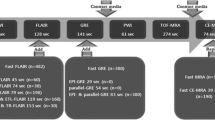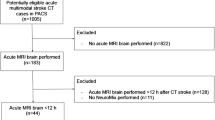Abstract
In the hyperacute phase of stroke, occluded vessels can be seen as high signal on fast-FLAIR images or as absence of flow-related enhancement in maximum-intensity projection (MIP) MR angiography (MRA). To compare these techniques, we examined 53 patients within 6 h of a stroke, using a standardised MRI protocol including fast-FLAIR and 3D time-of-flight TOF MR to detect vessel occlusion or reduced flow corresponding to the suspected ischaemic territory. Brain infarcts were confirmed on MRI after 1–5 days in 41 cases (77 %). The overall accuracy of 3D-TOF MRA was 68 % and sensitivity, specificity, positive and negative predictive values were 67 %, 71 %, 87 %, and 43 % respectively. Values for the fast-FLAIR sequence were: 65 %, 85 %, 93 % and 44 %, with an overall accuracy of 70 %. The fast-FLAIR sequence was thus able to show occluded vessels or reduced flow with about the same accuracy as 3D-TOF MRA and enabled better prediction of the ischaemic area.
Similar content being viewed by others
Author information
Authors and Affiliations
Additional information
Received: 25 June 1998 Accepted: 3 September 1998
Rights and permissions
About this article
Cite this article
Cosnard, G., Duprez, T., Grandin, C. et al. Fast FLAIR sequence for detecting major vascular abnormalities during the hyperacute phase of stroke: a comparison with MR angiography. Neuroradiology 41, 342–346 (1999). https://doi.org/10.1007/s002340050761
Issue Date:
DOI: https://doi.org/10.1007/s002340050761




